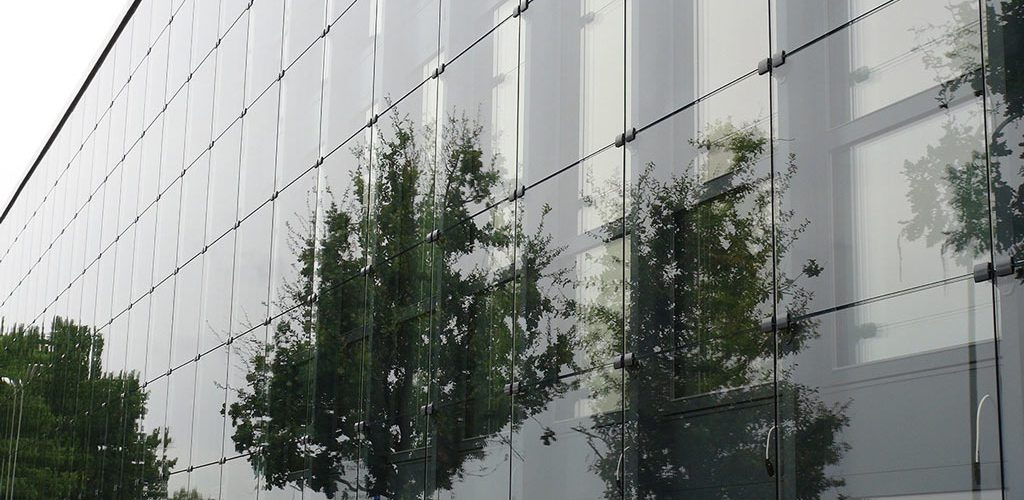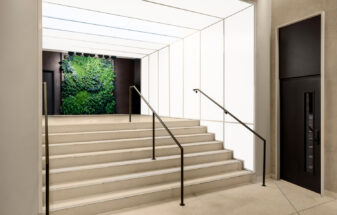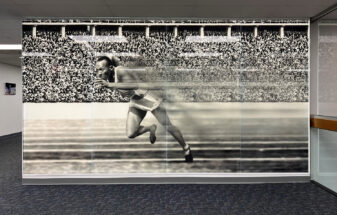Enhanced Rainscreen Technology Benefits New Construction
Bendheim rainscreen systems help create beautiful & long-lasting buildings, protecting our collective architectural legacy
What is a Rainscreen?
A rainscreen is an exterior wall cladding that stands off from the building’s exterior weather-resistant barrier. It envelopes and protects the building facade from water infiltration, controlling water drainage and evaporation. In lay terms, a rainscreen is akin to an elegant raincoat that protects the building from the elements, while delivering an added dose of style.

Eppley Airfield, Omaha, NE by HDR. Photo by Jen Miret.
Role of Rainscreens & Glass in Architectural Landmarks through History
Rainscreens can be a key component in the protection and preservation of buildings of importance, shielding them from the elements, ensuring their structural viability, and helping extend their productive life.
Although a modern concept in the United States, the rainscreen principle is not new. Rainscreen design has been proven throughout Europe with installations dating back to the Middle Ages. Early examples of rainscreens can be found in some Norwegian churches built centuries ago using layers of open-joint, drained, back-ventilated wood claddings set over a traditional wood or stone wall. Many of these historic structures are still standing today, including a stave church in Urnes, Norway (circa 1130). It is considered by some to be the oldest standing example of a rainscreen.
The Middle Ages saw the rise of another architectural technology – large-scale decorative glazed openings. Spurred by advancements in window making, medieval architects introduced monumental stained glass windows: Masterpieces that brought light, color, and beauty into buildings of importance.

Restoration of historic Kinnick Stadium with Bendheim’s glass rainscreen. Iowa City, IA by Neumann Monson Architects and HNTB. Photo by Cameron Campbell, AIA.
Enhancing Rainscreens – Bendheim Decorative Glass Rainscreen Systems with Längle Compression Fittings
Bendheim’s glass rainscreen systems are unique, multi-functional glass wall systems. They can add elegance to a building facade with a stunning array of decorative architectural glass options. These highly functional walls of glass can also preserve newly built structures for posterity, safeguarding the legacy of building creators and owners.
Decorative architectural glass has been defining the identities of powerful architectural monuments since the Middle Ages, and continues to do so to this day. Colored and patterned decorative glass is enjoying tremendous popularity, creating dynamic, stimulating environments and prominent building facades. Recent developments, such as colored, patterned and photographic printed interlayers, as well as direct-to-glass printing techniques, make glass facades the perfect medium for large-scale creative architectural expression.
According to contemporary architect and color expert Fiona McLachlan, “Color generated through the play of light is never static and has the capacity to… tune and transform architectural space.” (Source: McLachlan, Fiona. “Architectural Colour in the Professional Palette.” London & New York: Routledge, 2012)
The unprecedented development of contemporary architectural glass technology makes decorative glass rainscreens an ideal building method to adopt in North America today. Furthermore, the inherent durability and ease of maintenance of non-porous glass surfaces is an undeniable benefit in contemporary rainscreen applications. There is no better building material to stand up to the punishing effects of water, wind, and time than glass.
One of the main purposes of Bendheim glass rainscreens is to shield a building from the elements. Water is the biggest factor in the premature deterioration of buildings. A dangerous leak can be created in the presence of the following three elements:
- water (rain, melting snow and ice);
- an opening or a weak point in the building envelope, through which water can penetrate; and
- pressure (wind force)
Bendheim glass rainscreen systems effectively protect the building from moisture by creating a barrier envelope around it. All exterior systems, including Wall-F (Flat), Wall-H (Horizontally Overlapping), and Wall-VH (Vertically-and-Horizontally Overlapping), have been tested in accordance with ASTM & AAMA requirements for Water Penetration, Pressure Equalization, Air Leakage, and Structural Performance. They performed admirably, having received the best rating for preventing water ingress. Bendheim Rainscreen Systems allow water to escape and air to circulate, reducing the risk of mold, mildew, and water damage. Any small amount of water making its way behind the glass is drained and channeled away from the building. Any water vapor is ventilated through the top of the system, as air circulates upward between the rainscreen and the exterior building wall.

Essex County College, West Caldwell, NJ by Netta Architects. Photo by Bendheim.
Next Steps
For more information on how to create a unique, protective glass rainscreen façade for your next project, please contact Bendheim at +1.800.221.7379, Option 5 or e-mail your requirements to rainscreens@bendheim.com.
Bendheim is one of the world’s foremost resources for specialty architectural glass. Founded in New York City in 1927, the fourth-generation, family-owned company offers a virtually unlimited range of in-stock and custom architectural glass varieties. Bendheim develops, fabricates, and distributes its products worldwide. The company maintains production facilities in New Jersey and an extensive showroom in New York City




